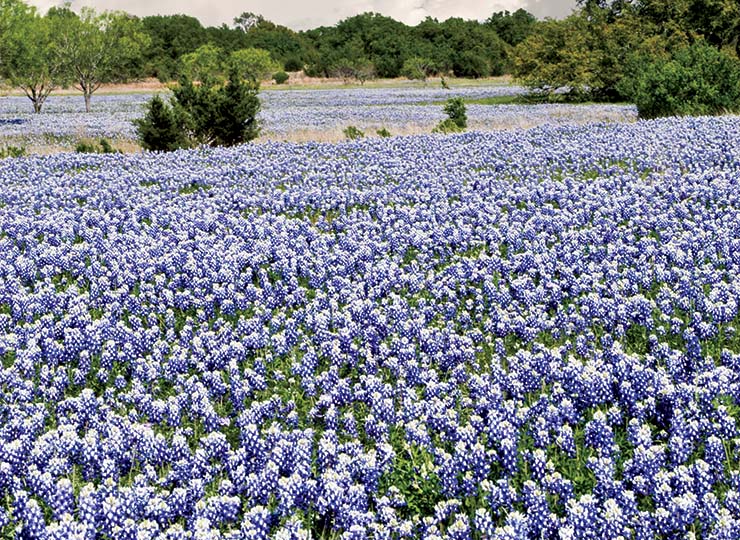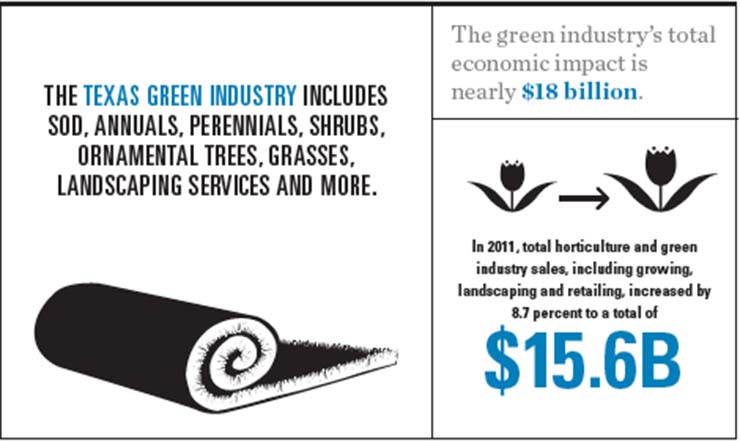Home > Texas > Texas Crops & Livestock > Texas Horticulture Business is Blooming
Texas Horticulture Business is Blooming
In partnership with: Texas Department of Agriculture

From March to May, one of the prettiest flowers in Texas – a state rich with plants, flowers and trees – is the Lady Bird Johnson Royal Bluebonnet. The robust plant with cobalt blue flowers is one of the Texas Superstars, a designation given to plants that do well in Texas weather and soil with minimal work.
Strong, healthy plants contribute to Texas’ economy. In 2011, total horticulture and green industry sales, which includes growing, landscaping and retailing, exceeded $15.6 billion, up 8.7 percent from the prior year, according to a report by the Texas A&M AgriLife Extension Service.
Factor in all aspects of the green industry, including manufacturing and equipment sales, and the economic impact increases to nearly $18 billion.
“The sales figures are strong, but the overall economic impact of the industry is even more impressive,” says Amy Graham, president of the Texas Nursery and Landscape Association. “You can’t buy sod or turf without also buying fertilizer and mowers.”
Landscape And Floral
Two key segments of Texas’ green industry are landscaping and floral.
“Production has increased over the last few years,” Graham says. “We represent more than 200,000 jobs in the state of Texas, and that’s a pretty exciting number.”
Graham expects retail sales to continue to rise as city residents become more interested in growing plants.
“Our industry has a cooling effect on urban heat centers,” she says. “Just as people are migrating to urban centers, so is horticulture. We’re seeing increases in rooftop gardens, container gardens and urban community gardens. In addition, interest in edible plants is expanding as more people are trying to grow their own food, and that’s great for our industry, people’s health and the environment.”

Industry Challenges
Even so, Graham says labor remains a challenge for the industry.
“It’s not just the immigration issue, it’s also the need to encourage young people to pursue higher education in the industry. We want people to understand that they can make a good living in the green industry,” she says.
Dianna Nordman, executive director of the Texas State Florists’ Association (TSFA), notes the concerns surrounding available workers for the industry.
“The industry as a whole is very healthy,” Nordman says. “What we lack are qualified employees and future owners. Our association is working to educate teachers and students about opportunities in the floral industry.”
TSFA has taken an important step to address the lack of workers by partnering with the state to develop the Texas High School Floral Certification program. More than 800 high school students across the state have achieved level one design certification, which qualifies them to create the basic designs used in a florist shop on a daily basis.

The organization also is working to protect and strengthen sales for local florists all across the state, including addressing a relatively recent trend.
“Obituaries are including the phrase ‘in lieu of flowers’ along with encouragement to make a donation to honor the loved one,” she says. “Our association is very supportive of people making donations, but what’s happening is that people are going to funerals and memorial services and not seeing the display of flowers that represent thoughtfulness and love. We’re working with funeral directors on that message.”
Graham believes plants and flowers should be part of every environment and occasion.
“We don’t consider plants a luxury purchase,” she says. “Studies have shown that plants increase the quality of peoples’ lives. People who garden are happier. They have scabby knees, but happy hearts.”
One of Texas’ most renowned citizens and flower gardeners would agree. Lady Bird Johnson herself once said, “Where flowers bloom, there is hope.”



